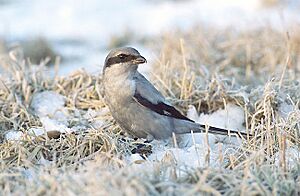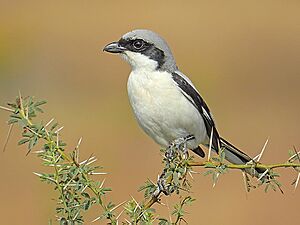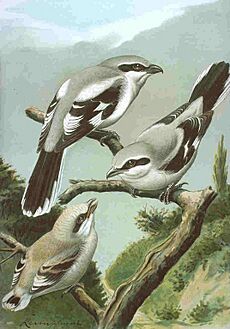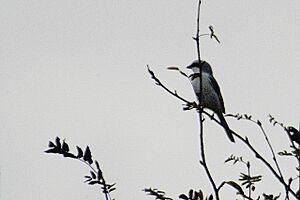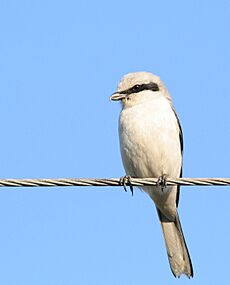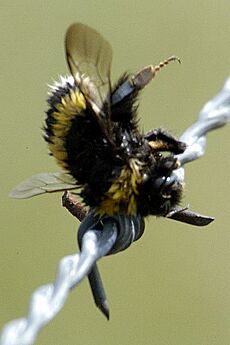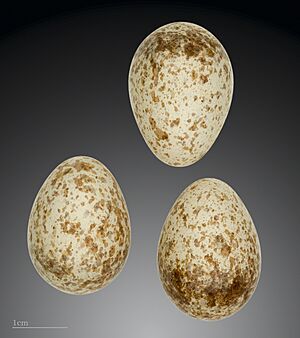Great grey shrike facts for kids
Quick facts for kids Great grey shrike |
|
|---|---|
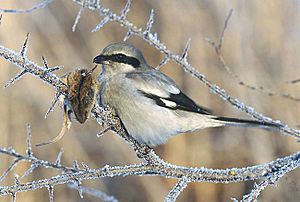 |
|
| The Lanius excubitor excubitor subspecies. Notice the striped field mouse it caught and put on a thorn! |
|
| Conservation status | |
| Scientific classification | |
| Genus: |
Lanius
|
| Species: |
excubitor
|
| Subspecies | |
|
See text |
|
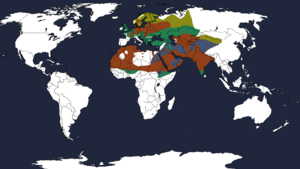 |
|
| Where the Great Grey Shrike lives: Red means they live there all year, yellow means they breed there, green means they visit in winter, and blue means they pass through. | |
The Great Grey Shrike (Lanius excubitor) is a large songbird known for hunting. It belongs to the shrike family, Laniidae. This bird is part of a group of similar shrikes, including the Iberian grey shrike, Chinese grey shrike, and loggerhead shrike. Both male and female Great Grey Shrikes look alike. They have pearly grey feathers on their backs, a black mask around their eyes, and white feathers underneath.
These birds usually breed in northern Europe and Asia, north of 50 degrees latitude. Most of them fly south to warmer areas for winter. The Great Grey Shrike eats meat, and more than half of its diet is made up of small rodents.
Contents
About the Great Grey Shrike's Name
The famous scientist Carl Linnaeus first described this bird in 1758. He gave it the scientific name Lanius excubitor.
The scientific name Lanius excubitor has a special meaning. Lanius is Latin for "butcher," and excubitor means "watchman" or "sentinel." This name describes two main things the bird does: it stores its food by sticking it on thorns (like a butcher), and it watches for prey from high places (like a watchman). Linnaeus chose the name because the bird "watches for approaching hawks and announces the presence of songbirds."
The common English name "shrike" comes from an old English word, scríc, which means "shriek." This refers to the bird's loud call.
Old Names for the Shrike
People used to call this bird by many different names. In parts of England and Germany, it was called Wereangel or Würgeengel, which means "choking angel." This name likely came from its habit of impaling prey.
Another old name was Neuntöter, meaning "killer of nine." This name refers to the shrike's habit of storing many prey animals in its "larder."
Some falconers (people who hunt with falcons) called it mattagesse, which might mean "magpie killer" or "killer magpie." This is because some people thought the shrike was a type of magpie.
Family Tree and History
The shrike family is part of a very old group of songbirds called Corvoidea. Their closest relatives are probably Corvidae (crows and their relatives). We don't have much information about how shrikes evolved, but the Lanius group of shrikes has been around since the Miocene era, about 6 million years ago.
The Great Grey Shrike and its close relatives form a group called a "superspecies." These relatives include the Iberian grey shrike, steppe grey shrike, Chinese grey shrike, and loggerhead shrike. This group likely started in the eastern Mediterranean area. The southern grey shrike is the oldest form in this group. The other three types developed as they spread into cooler regions.
Different Types of Great Grey Shrikes
There are several different subspecies, or types, of Great Grey Shrikes:
- Lanius excubitor excubitor: Lives in cooler parts of Europe and northwest Siberia. It is medium grey with some white on its wings.
- Lanius excubitor homeyeri: Found in southeast Europe and southwest Siberia. It is lighter grey than excubitor and has more white on its wings.
- Lanius excubitor koenigi: Lives only on the Canary Islands.
- Lanius excubitor algeriensis: Found along the coast of northwestern Africa.
- Lanius excubitor elegans: Lives from Eastern Morocco to Egypt and southwestern Israel.
- Lanius excubitor leucopygos: Found from central Mauritania to central Sudan.
- Lanius excubitor aucheri: Lives from east-central Sudan to Iraq and Iran.
- Lanius excubitor theresae: Found in southern Lebanon and northern Israel.
- Lanius excubitor buryi: Lives only in Yemen.
- Lanius excubitor uncinatus: Lives only on Socotra Island.
- Lanius excubitor lahtora: Found from Pakistan through India to western Bangladesh.
- Lanius excubitor pallidirostris (Steppe grey shrike): Lives in Central Asia and parts of northern China.
What the Great Grey Shrike Looks Like
An adult Great Grey Shrike is a medium-sized bird, about the size of a large thrush. It is about 22 to 26 centimeters (9 to 10 inches) long. It usually weighs between 60 to 70 grams (2 to 2.5 ounces). Its wings are about 11.4 cm (4.5 in) long, and its tail is about 10.9 cm (4.3 in) long. Its beak is about 23 mm (0.9 in) long. The wingspan can be from 30 to 36 cm (12 to 14 in).
The bird's back is pearl grey. Its cheeks, chin, and a thin line above its eye are white. A dark black mask goes from its beak through its eye to its ear feathers. Its shoulder feathers are white. The wings are black with a white bar, which is made by the white bases of its main flight feathers. The tail is black, long, and pointed, with white edges on the outer feathers. Its belly is white, sometimes with a light grey tint. The chest might look a bit darker. The beak is large and hooked at the tip, mostly black but lighter at the base of the lower part. Its legs and feet are blackish.
Males and females are similar in size and look. Females usually have greyer underparts and may have faint brownish bars on their chest. Their white wing and tail markings are also a bit smaller. Young birds are brownish-grey all over, with bars on their back and faint white markings. They get their adult feathers in their first spring.
What the Shrike Sounds Like
The male shrike's song is a mix of pleasant warbling sounds and clear whistles. For example, it might sound like tu-tu-krr-pree-pree or trr-turit trr-turit. When it sees someone entering its territory, it makes long, sharp, raspy whistles like trrii(u) or (t')kwiiet. It often mixes these whistles with its song when trying to attract a female.
Different contact calls include chlie(p), gihrrr, kwä, or wuut. These calls are often heard during courtship. When a male shows a female potential nest sites, he makes a lively chattering sound with fluting tli-tli and trills.
If disturbed, its alarm call is a harsh, jay-like k(w)eee, greee, or jaaa. If it gets more excited, the calls become higher and faster, like chek-chek-chek or an explosive aak-aak-aak. It warns about birds of prey with a whistle like breezeek. Adults make Knuk calls if their young are in danger. Young birds or mates begging for food make waik calls. Sometimes, this bird will copy the calls of small songbirds to trick them into coming closer so it can catch them for food.
Other Shrikes That Look Similar
The Iberian grey shrike (L. meridionalis) used to be considered the same species as the Great Grey Shrike. It lives in southwestern Europe. It prefers dry shrubland, while the Great Grey Shrike likes open grasslands. Where their areas overlap, they usually do not breed together.
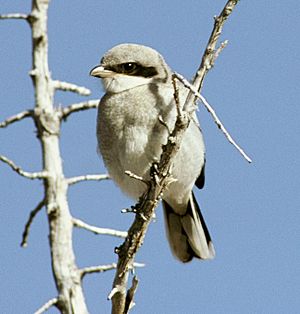
Other similar shrikes include the Chinese grey shrike from East Asia and the loggerhead shrike from North America. The Great Grey Shrike spends winters in the northern parts of these relatives' ranges.
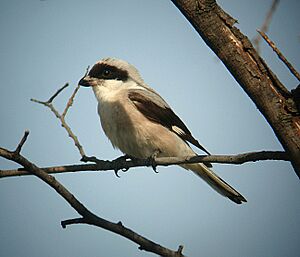
The Iberian grey shrike is usually a clearer and darker grey on its back. Its belly and chest are often pinkish, not just grey. The white "eyebrow" extends over its beak, which has a larger pale base. Young Iberian grey shrikes have fewer bar patterns.
The Chinese grey shrike is larger and has much bigger white areas on its wings and tail.
The loggerhead shrike is hard to tell apart, but its head seems larger compared to its all-dark beak. The name "loggerhead" actually refers to the southern species' relatively larger head.
The lesser grey shrike is smaller and has a shorter tail. You can tell it apart by the large black area above its beak, which almost reaches its forehead and has no white stripe above it. When flying, the Lesser Grey Shrike's tail end is wide, not pointed.
Where the Great Grey Shrike Lives and What It Likes
The Great Grey Shrike breeds in Europe, Asia, and northern Africa. It can be found as far north as 70 degrees latitude. It is rarely seen in places like Iceland, the British Isles, and Korea. In some parts of Switzerland, the Netherlands, and southern Germany, small populations have disappeared since the mid-20th century.
Most Great Grey Shrikes fly shorter distances for winter, except for some that stay all year in milder European areas. They migrate when food becomes scarce. Females tend to migrate more than males. Birds leave for winter between July and October and return to breed in March or April. In recent years, more birds have been staying in their breeding areas all year, for example, in Fennoscandia.
The shrike prefers open grassland with some shrubs and high places to watch from. These lookout points are usually trees, fence posts, power lines, or rocks. It needs about 5 to 15 perching spots per hectare (about 2.5 acres) of habitat. It avoids areas with only low grass and no lookout points or nesting trees, as well as dense forests. Besides grasslands, they hunt in bogs, clearings, or fields.
Shrike Behaviour
Great Grey Shrikes are territorial, meaning they defend their own space. However, they like to breed in groups of about six or more adults. We don't know if these birds in a group are related. In warmer areas, groups might be about 5 kilometers (3 miles) apart. Individual territories within a group can be as small as 20 hectares (50 acres) but are usually twice that size. In colder places, territories can be over 350 hectares (1.4 square miles).
During the breeding season, mated pairs and single males looking for a partner hold territories. In less productive areas, some birds called "floaters" hold territories for shorter times. This means the number of birds in an area can change as "floaters" move around looking for a good territory or a mate. In winter, pairs separate because there is less food. If both birds migrate, their wintering spots are usually close to each other. Once a shrike finds a winter territory it likes, it often returns there each year and may defend it.
Before and after the nesting season, groups of breeding birds sometimes gather. These meetings happen at the edge of their combined territory. A bird starts the gathering with a special flight: it spirals high into the air, hovers briefly, and then glides down. Other birds respond by doing the same flight. Eventually, about half the group will fly to a meeting spot, usually a small tree or bush. They will spend a long time there chattering, calling, and moving around excitedly. In winter, birds often gather in small groups to roost together, especially to stay warm at night.
The Great Grey Shrike's flight is wavy and seems a bit heavy, but it can fly straight and fast when it wants to. It can also hover in the air for short periods, repeating this because it has a lot of energy. It usually flies low to the ground, approaching perches from below and landing with an upward swoop.
When birds are aggressive, they stand tall, fan and flick their tail, and sometimes their wings. If they are ready to attack, they crouch down and fluff their feathers, making a small crest on their head. To calm down another shrike, they might turn their head away or act like a young bird begging for food. To prevent an attack, a shrike will point its beak straight up.
Young birds change some of their feathers before their first winter and the rest in spring. Adult birds change their feathers before migrating or before winter if they stay in one place. Changing feathers takes a lot of energy, but it helps the bird stay healthy and attractive, which can help them breed successfully.
What the Shrike Eats and How It Hunts
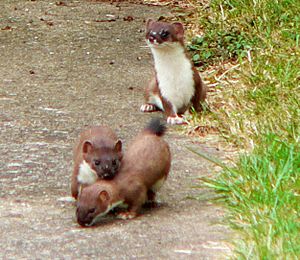
The Great Grey Shrike eats small animals with backbones (vertebrates) and large insects (invertebrates). To hunt, it sits on a high spot like a tree branch or utility pole, usually 1 to 18 meters (3 to 60 feet) off the ground. It can also hover in the air for up to 20 minutes, looking for prey below. It drops down to catch animals on the ground or swoops like a hawk to catch flying insects. It sometimes catches small birds in flight by approaching them from behind and grabbing their feet with its beak. If no prey appears, shrikes will search through bushes or sit near hiding places and flash their white wing and tail markings to scare small animals out. As mentioned before, they sometimes copy songbirds' calls to lure them closer.
Usually, more than half of the shrike's food is small rodents like voles and mice. Shrews, songbirds, lizards, and frogs are also eaten. Birds are not a major food source, except in spring when male songbirds are busy courting, in late summer when young birds are inexperienced, and in winter when most small mammals are hibernating. Occasionally, they eat bats, newts, and even fish. Sometimes, they catch animals almost as big as themselves, like young stoats.
Large insects are the second most important food source, especially beetles, crickets, grasshoppers, and bumblebees. They also eat spiders, scorpions, and snails. They rarely eat dead animals or berries.
Shrikes kill their prey by hitting its head with their hooked beak. If the prey is too big to swallow whole, they carry it to a feeding spot. They can't tear prey with their feet, so they stick it on a sharp point, like a thorn or barbed wire, or wedge it between branches. This way, they can rip the food into smaller pieces with their beak. They might leave insects with bad chemicals on thorns for a few days until the chemicals break down. Great Grey Shrikes have even been seen skinning common toads to avoid their toxic skin. They usually don't eat large bones, but smaller ones are swallowed and later coughed up as pellets.
An adult shrike needs about 50 grams (1.8 ounces) of prey per day, maybe more in winter. This means one or two rodents, plus other small animals and insects. They store extra food in "larders," which are usually about 1 meter (3 feet) above the ground, often near their nests.
Reproduction and Life Cycle
Great Grey Shrikes usually breed once a year during the summer. If conditions are very good, they might have two broods. If their first set of eggs is destroyed, they usually lay a second set. They form a strong pair bond during breeding season, but it often loosens in winter, so they might choose a different mate next year.
Males fly outside their breeding areas to find mates. If a female likes a male, she will visit his territory to see if they get along and to check out his nesting spots. The courtship period usually lasts from March to April or May. At first, the female might not accept the male, only letting him feed her. Males sing more and show off the white markings on their wings and tail. Eventually, the female joins in the displays, and their songs become duets. To show off their hunting skills, males make their food caches in easy-to-see places during this time. When showing nesting sites, males make special calls and move their head and fanned tail.

Mating usually starts when the male brings an attractive prey item to the female. When eggs are about to be laid, the male guards his partner closely, watching for dangers and feeding her often. This helps her stay healthy. A female can lay a full set of eggs in about 10 to 15 days.
Nests are built in April or May, usually more than 1 meter (3 feet) above the ground in trees. Most nests are 2 to 16 meters (6.5 to 52 feet) high, though some have been found almost 40 meters (130 feet) up. Trees with mistletoe or common ivy are more attractive for nesting. Fieldfares nesting nearby also make a spot more desirable for shrikes. The two species seem to work together to spot and chase away nest predators like corvids. Shrikes use different types of trees for nesting, as long as they are dense enough. Sometimes, they use large, thorny bushes. The male chooses the nest site, and both partners build the nest, but the male collects most of the materials.
The nest is quite large, about 20 to 28 cm (8 to 11 in) wide on the outside. The inside cup is 8 to 12 cm (3 to 5 in) wide and 10 to 15 cm (4 to 6 in) deep. It is made of coarse plant material like twigs and moss, sometimes with fabric or rubbish. The inside is lined with fine twigs, roots, lichen, hair, and feathers. Building a nest takes one to two weeks. If old nests are still good, they are repaired instead of building new ones.
Laying eggs usually happens in May. A clutch has 3 to 9 eggs, but typically around 7. North American clutches tend to be larger than European ones. If a second clutch is laid in one season, it will be smaller. The eggs are white, often with a grey or blue tint, and have yellowish-brown and purplish-grey spots, usually denser at the wider end. They are about 26 mm (1 in) long and 19.5 mm (0.8 in) wide.
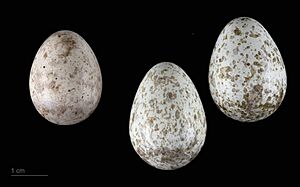
Incubation (keeping the eggs warm) takes about 16 days, but can be longer for large clutches. Only the female usually incubates, while the male brings her food. The young birds hatch naked, blind, and pink, weighing about 4 grams (0.14 ounces). Their skin darkens after a few days. As they grow, the female broods them and helps feed them. The young birds leave the nest after 2 to 3 weeks, usually in late June or early July. They become independent from their parents about 3 to 6 weeks later. Sometimes, other adults help feed a pair's young.
In the past, common cuckoos sometimes laid their eggs in Great Grey Shrike nests, making the shrikes raise cuckoo chicks. However, this seems to have stopped since the late 1970s. The main predators of shrike eggs and nestlings are corvids (like crows and jays), which are actually close relatives of shrikes.
Usually, more than half of all nests successfully hatch at least one young, and about three-quarters of all eggs laid hatch. Half to three-quarters of the hatched young successfully leave the nest. They become ready to breed in their first spring. On average, Great Grey Shrikes get to breed about four times in their lives. Most wild birds are eaten by birds of prey or carnivorous mammals, or die from other causes, before their fifth winter ends. Birds of prey are the main threat to shrikes after they leave the nest. The longest recorded lifespan for a Great Grey Shrike is 12 years.
Conservation Status
The Great Grey Shrike is no longer found breeding in Switzerland and the Netherlands. Overall, its numbers in Europe have been decreasing since the 1970s. This decline seems to be related to changes in how land is used. For example, after World War II, more land was left unused, which helped the shrikes. But then, when land was reorganized and hedgerows (which shrikes use for hunting and nesting) were removed, their numbers went down. The widespread use of pesticides in the 1960s also likely harmed the birds, as these chemicals can build up in predators and affect their breeding.
Despite these declines in some areas, the Great Grey Shrike is still common and widespread. The IUCN (International Union for Conservation of Nature) does not consider it a threatened species. In many countries, there are hundreds or even thousands of these birds. Sweden is a stronghold, with an estimated 20,000 to 50,000 birds in the late 20th century. However, in some countries like Estonia, Belgium, Latvia, and Lithuania, there are only a few hundred or even fewer than 100 birds. In Luxembourg, there is plenty of good habitat, and the bird density is very high, even though the total number of birds is small due to the country's size.
Images for kids
-
Unlike reed-warblers (Acrocephalus), the Great Grey Shrike seems to have avoided being a host for the common cuckoo for now.



